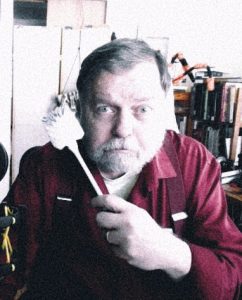Another genetics class video — our first fly lab is this week, so they’re going to set up the parental stocks for a complementation assay.
Another genetics class video — our first fly lab is this week, so they’re going to set up the parental stocks for a complementation assay.
Hooray for me! I got step #4 of my to-do list, and also step #3.
Tomorrow I’ll go back and get #2 (“Record a video summary of the fly culturing procedure”) done, and also #6 (“edit the fly culture video”), and then on to chromosomes, mitosis, and meiosis. I’m trying hard to build up slowly with a solid foundation before we get to the hard stuff.
There is a giant space rock hurtling towards Earth! It is predicted to miss, and usually I’d trust the math and physics, but given the Bayesian priors of our experiences the last few years, I would not be surprised if they forgot to carry the 3.
Anyway, the Virtual Telescope Project will be showing it live, in about an hour. You might want to watch it, just in case.
Unfortunately, the stupid asteroid scheduled its closest approach for when I’ll be in class. I guess I’ll have to watch it after the fact, I hope.
In about 5 hours, we’ll be gathering for a conversation about, oh boy, the pandemic. Expect different perspectives, but none of them crazy.
Speaking of perspectives, we also have a guest this month: Dr Tara Smith. She’ll be providing the extremely well informed perspective.
If you have no idea what Silkhenge is, here’s a video:
It’s a curious ring of spider silk, with silk fenceposts, and then in the center, an egg sac with a silk spike coming off the top. It’s just weird, especially since it’s such an elaborate structure to house only a handful of spider eggs. It’s a lot of effort for a small reward. All we know is what the babies look like, no adults, and no observations of how it is constructed. Clearly, More Research is Needed.
The same people went back a few years later and found more examples, still no adults.
They’ve also been seen in Peru.
Do I need an excuse to visit Ecuador again? Will this do? (All exotic travel is pending the resolution of the pandemic, of course.)

That is my sad face. I went into the lab yesterday to get a bunch of things done, when I learned that the water to the whole building was shut off. Our science building is only about 20 years, but every year we have a battery of problems that shake out — rooms are too hot or too cold, the roof leaks, and come the winter, we often get pipes freezing and all the problems that causes. So no water for three days while the maintenance crew fixes everything.
This would have been catastrophic when I was working with fish, and it’s still awkward when working with spiders. On my list was the need to set up more flies so they’d have food in two weeks, washing spider poop out of their containers, and most tragic of all, I had set hundreds of vials soaking in soapy water the day before, and I was going to scrub ’em up and rinse them out and dry them yesterday.
Look! I even got a brand new bottle brush! I was so excited to be doing dishes, and then…crashing disappointment. I’ll have to wait until Thursday.
First, I must remind everyone that billionaire Rupert Murdoch elbowed his way to the front of the queue to get the vaccine as soon as it was announced, and that all those blithering conservative on-air personalities on Fox News are required to be vaccinated, just to put this story on Fox News’ promotion of quacks in perspective. It lists ten of the COVID denialist and anti-vax and tepid apologists for inaction who have been featured on the network many hundreds of times. Names you should learn to recognize and scorn: Marc Siegel, Martin Makary, Nicole Saphier, Rand Paul, Brett Giroir, Janette Nesheiwat, Jayanta Bhattacharya, Harvey Risch, Scott Atlas, and Peter McCullough. They all have the title of “Dr”, but you should know that the majority of doctors disagree with these scam artists; Fox News has been carefully distilling the population of MDs to purify and isolate the most untrustworthy scum to selectively display on popular programs by even more reprehensible filth like Carlson and Ingraham and Kudlow. You don’t get a prime time opinion/bloviation slot on Fox if you hold a reasonable view of the science.
Contrast that with this genuinely excellent interview with Jonathan Eisen, a biologist at UC Davis. Eisen simply and plainly says what every biologist and informed citizen knows about SARS-CoV-2.
The Omicron variant is way more infectious [than Delta]. It’s horribly contagious. Even people who are boosted are still getting infected. [The vaccine] does not seem to provide a huge protection against getting infected. I think that’s part of why it’s spreading so fast—people who have been vaccinated and/or boosted have mistakenly thought they were not going to get infected, and so they were going maskless everywhere. But if you have five times as many people infected, that’s going to create havoc, and that’s what is happening in New York and the Northeast, where the hospitals are full. They’re already sending people away who have any other types of emergency or nonemergency health needs. I think we’re in for some tough times; that’s my prediction.
Exactly. This is what I’m expecting, too. It’s also what everyone who isn’t brainwashed by Fox News can figure out. So what should we do?
All the evidence right now shows that vaccines are incredibly effective in reducing the risk of severe illness and death from Covid. And this is true even for new variants such as Delta and Omicron, even though the vaccines were not specifically designed for them. One can reduce the risk of severe illness even more by getting a booster shot. This reduction in risk is very, very clear from all the data. The one issue with Omicron that is different than with other variants is that just getting the regular vaccine dose (e.g., two Pfizer shots) does not reduce the risk of severe illness as much as it did for other variants. In other words, to reduce the risk of severe illness or death, it seems that a booster is very important here.
This is what infuriates me. Everyone wants the quick fix, the easy treatment, the simplest, most painless way to prevent this disease, and science provides one: the vaccine. Go in to the clinic or pharmacy, poke, you’re done, death averted. And what happens? People who listen to Fox News whine, “I want an insta-fix, but not that one.” They’d rather dose themselves with hydroxychloroquine or ivermectin or bleach or betadine, treatments that don’t work, than take the medicine proven to work.
In a world with people who refuse the treatment that works, and other people who can’t, for other medical reasons, get the vaccine, what can we do to protect ourselves. That’s also easy. Wear a mask in public.
What I’m hoping is that people do a lot of behavioral intervention that can slow down the spread of the Omicron variant. It goes back to the whole “flattening the curve” thing from before, and there are many things we can do. If you’re in crowded indoor spaces, you can avoid doing things where you have to take off your mask—so, no eating. But even with your mask on, not all masks are created equal. There’s new guidance that has come out in the last few days that cloth masks just aren’t going to cut it against Omicron. They just do not, on their own, filter enough particles out to reduce your exposure when airspace is getting filled with virus. What you want is a KN95 or N95 mask.
Yes. Masks aren’t the imposition the whiny-ass-titty-babies of conservatism pretend they are. When I’m teaching, I wear them continuously all day long with no difficulty, other than that I’m generally soft-voiced and muffling me doesn’t help (I’m working on it by TALKING LOUDER with my teaching voice). I tried to order some N95 masks in time for spring classes, but right now they’re backlogged and horribly expensive, so I settled for N94…still expensive with slow delivery — I think they’re all coming from South Korea — but I’ll double-up with a cloth mask until N95s become more available, I hope. If they do.
Eisen mentions also that he avoids big indoor events, even restaurants, and won’t fly, although he thinks if everyone on the plane takes reasonable precautions it’s probably safe. It’s just that too many people have been infected with the Fox brain-rot. Just glance at YouTube fights over masks on airplanes — people are getting into brawls in the aisles because they refuse to wear a mask. It’s nuts.
I avoid going out because I live in a county where practically no one wears a mask, ever. Even when our governor imposed a mask mandate, briefly, a lot of people ignored it, and our local business wouldn’t enforce it — and even then, half the population was incapable of figuring out that the mask covers your mouth and nose. It was good news when my university reluctantly decided to require masks and vaccines for all of our incoming students, but we’re a tiny island of common sense in an ocean of conservative denialists of basic medical facts.
We also need to worry about the long-term consequences of infection. Idiots like those talking heads on Fox News want to pretend it’s just a kind of flu, you get over it and carry on, but COVID has complications you ignore at your own peril.
That is one of my biggest concerns with this attitude of not worrying about Omicron too much because it might cause less severe symptoms. We know that long Covid is a problem for the other variants. It’s a big problem that is poorly understood medically, but is very clearly a real thing. These are real medical problems that people are having for months to now years after infection. Some people are saying everybody is going to eventually get Omicron, and that’s just the wrong attitude. We can make it so that not everybody gets it, and therefore reduce the risk of long Covid in too many people. We can’t just let it spread to everyone on the globe, because that’s going to be a medical catastrophe. Now is not the time to do nothing and hope for the best. It is the time to take measures while at the same time trying not to damage people’s lifestyles and lives and the economy.
Eisen’s is the kind of sensible voice we ought to have been hearing all along in our news media, providing accurate, honest information. I guess Rupert Murdoch knows that that doesn’t sell, unfortunately. And that’s why we’re screwed right now.

I have discovered a subreddit called Abandoned Porn. This is very much my kind of porn : photos of old, crumbling, abandoned buildings. Very romantic. So tempting. I made a kind of Homer gurgle when I stumbled across it.



Imagine the spiders in there! I want to go exploring…this summer, I hope. I have to get over this annoying tendinitis (I can walk without pain now, I’m just at the stage of having to be very careful not to worsen anything), and then start casing a few joints in the region. Then, new spider survey! In empty buildings where a pandemic can’t bring everything to a screeching halt! I’m going to have to put this in my to-do list:
Wait for the snow to melt.
Rummage through the wreckage of ancient days.
I’ve got a couple of hardhats with helmet lights, and a collection of bright portable LED lights. I should probably get some nice steel-toed boots with good ankle support.
I should also stake out some sites that aren’t abandoned ruins for comparison.

All the final exams have been turned in, so now it’s time to sit my butt down and read them all. I’ve got two classes with about 25 students each, so here’s what I am to complete this weekend. These were all due on Friday, yesterday.
Comprehensive Final Exam for Fundamentals of Genetics, Evolution, and Development. This is the monster, 7 pages of questions in different formats that cover the topics in the title of the course and also a bit of the history and philosophy of science. FunGenEvoDevo is a first year overview course that doesn’t dig too deeply, but prepares them with the general background (there is also another intro course, Evolution of Biodiversity, that hits them with evolution again and also basics of ecology and systematics). I started on this one yesterday, and am a bit more than halfway through; I plan to finish it by this afternoon.
Lab Final for Cell Biology. Another longish exam, this one emphasizes basic quantitative skills they should have learned in the lab. So lots of questions about unit conversions, calculating concentrations, interpreting data, etc. For instance, they get some measurements of reaction rates, and they then have to calculate enzymatic Km and Vmax. There are a lot of parts to this one, too, but most of the answers are short, specific, and numeric, which are relatively easy to grade.
Required Final Essay for Cell Biology. Oh boy, this will be challenging. I gave them a paper to read (“How energy flow shapes cell evolution” by Nick Lane) and asked them to summarize it and relate it all to the content of the course. On this one, I demand high writing standards and coherence in addressing the subject, so we’ll see how that goes.
Optional Final Exam for Cell Biology. Another big ol’ comprehensive exam, but this one is optional for the students: whatever score they get on the final will replace their lowest midterm score. Everyone has a bad day, so this is their opportunity to vindicate themselves. It’s a long exam, but grading it might not be too bad — only about a third of the class has opted to do it.
So that’s my weekend! This is all I’m doing for a few days. I hope to get it all done by Sunday evening and get all those grades submitted to the registrar early.
Then on Monday I have one more class to grade, Biological Communications II, in which students spend the semester writing a 10+ page review paper under my tutelage, so I already have a good idea of what they’ve done — I just have to go over what is supposed to be the final polished draft of the paper. And then I’m ALL DONE!
I guess I better buckle down and get to work now.
10:45 Saturday: FunGenEvoDevo done! Grades submitted! Students mostly did OK, but a few of them may have learned that skipping an exam or two is a good way to fail a course.
3:45 Saturday: Lab final done! Starting on the required final essay.
1pm Sunday: Required lab final done! Now to polish off the optional final.

All of my final exams came due last night at midnight — they were all fortuitously scheduled for the last day of finals week — so I got to open my mailbox this morning to find an expected mountain of papers to grade. Oh joy. There goes my weekend. Also, my flies arrived late yesterday, so I’ve got to go in to the lab today and get the stocks set up for my spring genetics course. That course, by the way, is going to be taught entirely in person, because my university has been applying some gentle pressure on the faculty to pretend the pandemic is completely over and we can all go back to normal. To be fair, I really want to get back to normal, too, but I’m also realistic enough to know that what I desire isn’t necessarily what I’ll get. The university is not adjusting any of its policies to deal with the threat of the new Omicron variant, and is in fact loosening them. As usual, we’ll wait until a crisis is upon us and only then start changing things, too little and too late, to try and catch up to a disease that’s running ahead of us right now. And my university is relatively progressive compared to the western Minnesota community, and the Minnesota governor!
My next few days are going to be bogged down in work, and then my so-called Christmas “break” I’m going to be tied up in that magic word, preparation, for the next semester, which I’m required to take seriously, unlike the administration. Wouldn’t it be nice if I could submit my grades next week and then take a nap or play with spiders or you know, just relax, until 18 January, when classes resume? Nope, isn’t going to happen. Especially since I have a looming dread that this is going to be an abortion of a semester, that we’ll go in assuming an air of nonchalant normalcy, and at some point we’re going to get screaming panicky emails from the administration telling us the quarantine spaces are all full, the local hospital is full, the pandemic is spiking, change your class management and go into lockdown. I figure I’ve got to prepare for two classes, not just one, an in-person version and a remote version. Thanks, procrastinators on high!
And then Ed Yong has to come along and splash stinky reality all over me.
OK, I can’t blame him. I know this stuff, but hey, I’ve been trying to close my eyes and pretend it isn’t as bad as it probably will be. Omicron should open everyone’s eyes to the new normal, that because we refuse to do what needs to be done, we’re going to get new variants every year, and we’re going to have to learn to live with new levels of unpredictability.
America was not prepared for COVID-19 when it arrived. It was not prepared for last winter’s surge. It was not prepared for Delta’s arrival in the summer or its current winter assault. More than 1,000 Americans are still dying of COVID every day, and more have died this year than last. Hospitalizations are rising in 42 states. The University of Nebraska Medical Center in Omaha, which entered the pandemic as arguably the best-prepared hospital in the country, recently went from 70 COVID patients to 110 in four days, leaving its staff “grasping for resolve,” the virologist John Lowe told me. And now comes Omicron.
Will the new and rapidly spreading variant overwhelm the U.S. health-care system? The question is moot because the system is already overwhelmed, in a way that is affecting all patients, COVID or otherwise. “The level of care that we’ve come to expect in our hospitals no longer exists,” Lowe said.
Because we don’t know what is going to happen, we need more discipline, more cohesive action, more cooperative behavior in our communities. That’s not the American way!
The real unknown is what an Omicron cross will do when it follows a Delta hook. Given what scientists have learned in the three weeks since Omicron’s discovery, “some of the absolute worst-case scenarios that were possible when we saw its genome are off the table, but so are some of the most hopeful scenarios,” Dylan Morris, an evolutionary biologist at UCLA, told me. In any case, America is not prepared for Omicron. The variant’s threat is far greater at the societal level than at the personal one, and policy makers have already cut themselves off from the tools needed to protect the populations they serve. Like the variants that preceded it, Omicron requires individuals to think and act for the collective good—which is to say, it poses a heightened version of the same challenge that the U.S. has failed for two straight years, in bipartisan fashion.
We’re not ready for omicron. How about pi, and rho, and sigma, and phi, and…we’re going to run out of Greek letters long before this is over. Oh, wait, “over”? It may not ever be over, at least, not until the recalcitrant and deluded are all dead. I was letting my guard down after I got my third booster, but I’m going to have to look forward to my fourth, and fifth, whatever it takes (at least we run no risk of running out of numbers), and I’m going to have to be less cocky. He says, while preparing to abandon isolation and spend 16 weeks in a classroom.
First, the bad news: In terms of catching the virus, everyone should assume that they are less protected than they were two months ago. As a crude shorthand, assume that Omicron negates one previous immunizing event—either an infection or a vaccine dose. Someone who considered themselves fully vaccinated in September would be just partially vaccinated now (and the official definition may change imminently). But someone who’s been boosted has the same ballpark level of protection against Omicron infection as a vaccinated-but-unboosted person did against Delta. The extra dose not only raises a recipient’s level of antibodies but also broadens their range, giving them better odds of recognizing the shape of even Omicron’s altered spike. In a small British study, a booster effectively doubled the level of protection that two Pfizer doses provided against Omicron infection.
Second, some worse news: Boosting isn’t a foolproof shield against Omicron. In South Africa, the variant managed to infect a cluster of seven people who were all boosted. And according to a CDC report, boosted Americans made up a third of the first known Omicron cases in the U.S. “People who thought that they wouldn’t have to worry about infection this winter if they had their booster do still have to worry about infection with Omicron,” Trevor Bedford, a virologist at Fred Hutchinson Cancer Research Center, told me. “I’ve been going to restaurants and movies, and now with Omicron, that will change.”
I guess I’ll be self-isolating at home from now on, except every day when I go in to work.
Omicron might not actually be intrinsically milder. In South Africa and the United Kingdom, it has mostly infected younger people, whose bouts of COVID-19 tend to be less severe. And in places with lots of prior immunity, it might have caused few hospitalizations or deaths simply because it has mostly infected hosts with some protection, as Natalie Dean, a biostatistician at Emory University, explained in a Twitter thread. That pattern could change once it reaches more vulnerable communities. (The widespread notion that viruses naturally evolve to become less virulent is mistaken, as the virologist Andrew Pekosz of Johns Hopkins University clarified in The New York Times.) Also, deaths and hospitalizations are not the only fates that matter. Supposedly “mild” bouts of COVID-19 have led to cases of long COVID, in which people struggle with debilitating symptoms for months (or even years), while struggling to get care or disability benefits.
And even if Omicron is milder, greater transmissibility will likely trump that reduced virulence. Omicron is spreading so quickly that a small proportion of severe cases could still flood hospitals. To avert that scenario, the variant would need to be substantially milder than Delta—especially because hospitals are already at a breaking point. Two years of trauma have pushed droves of health-care workers, including many of the most experienced and committed, to quit their job. The remaining staff is ever more exhausted and demoralized, and “exceptionally high numbers” can’t work because they got breakthrough Delta infections and had to be separated from vulnerable patients, John Lowe told me. This pattern will only worsen as Omicron spreads, if the large clusters among South African health-care workers are any indication. “In the West, we’ve painted ourselves into a corner because most countries have huge Delta waves and most of them are stretched to the limit of their health-care systems,” Emma Hodcroft, an epidemiologist at the University of Bern, in Switzerland, told me. “What happens if those waves get even bigger with Omicron?”
Ha ha, I know! Nothing! Nothing will change! The people in charge will keep pushing everyone to go back to work, the media will amusingly report without condemnation on all those assholes protesting against basic hygiene, and Republicans will be passing laws against accurate information and public health measures.
And then I die because I can’t get healthcare from a system clogged with people on ventilators who refused to get vaccinated. I’m calling it now.
